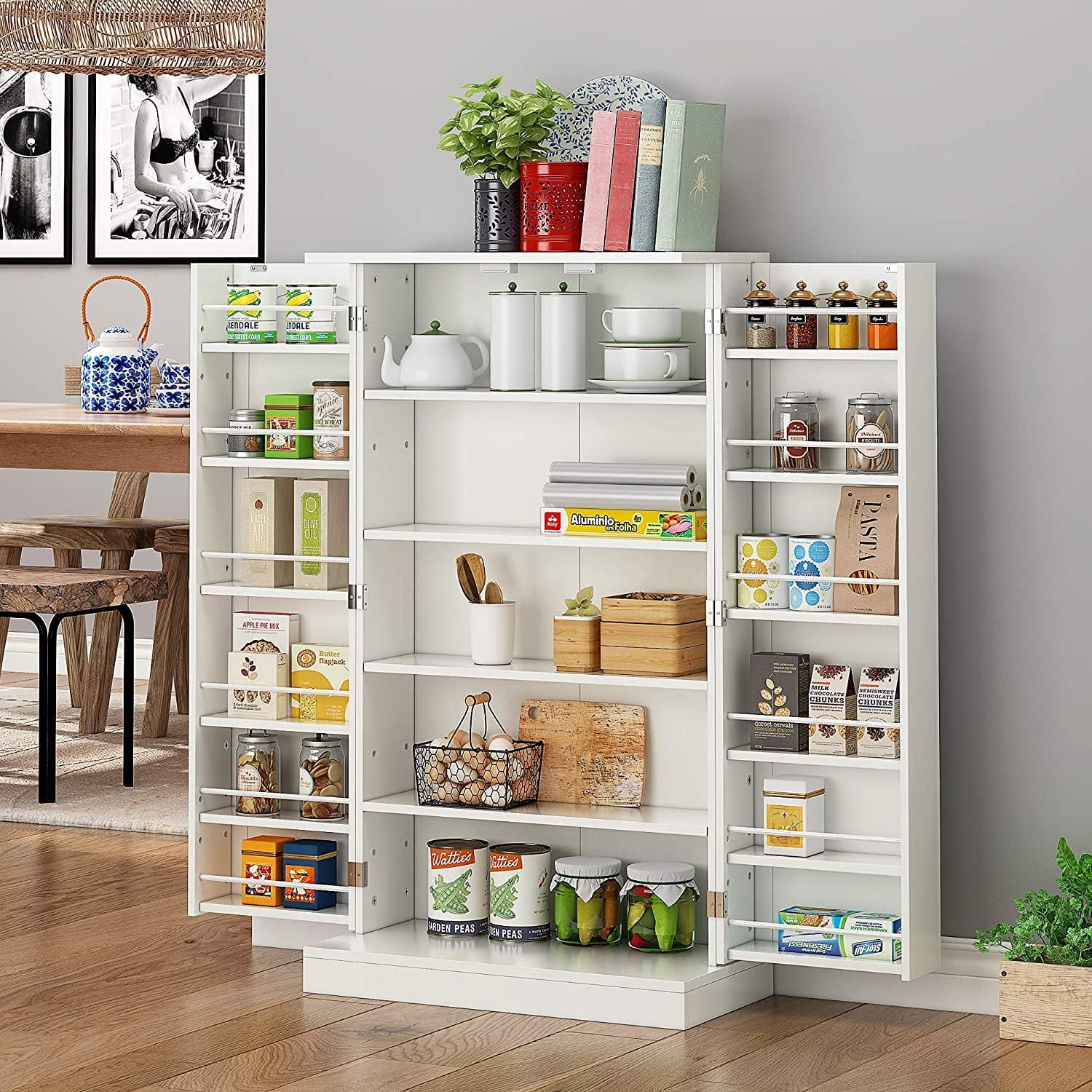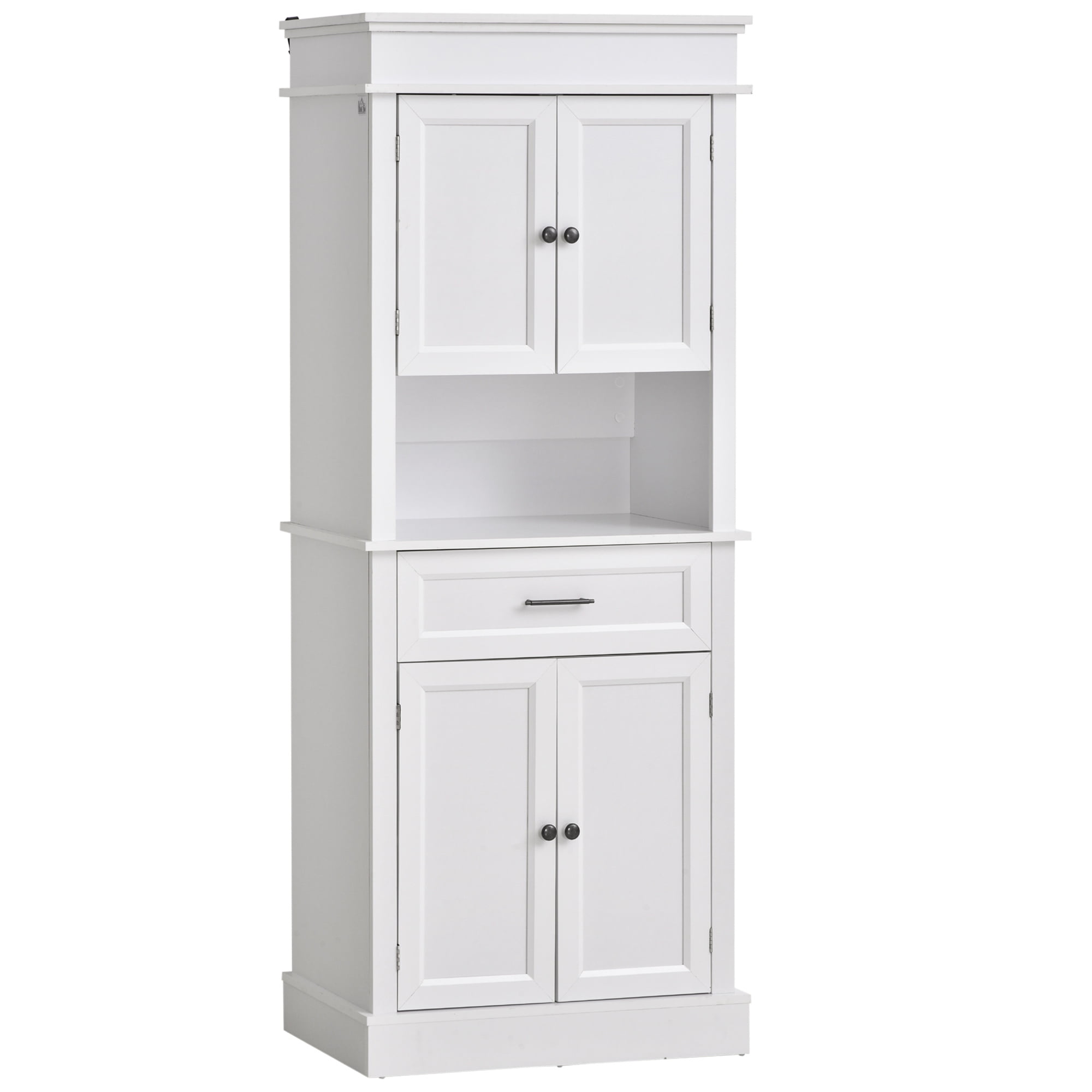Design Considerations for Standalone Food Pantry Cabinets

Creating the ideal standalone food pantry cabinet for a small kitchen requires careful consideration of space optimization, aesthetic appeal, and material selection. The goal is to maximize storage capacity without compromising on style or functionality. This involves a balance between practical design choices and a pleasing visual outcome.
Ideal Dimensions and Features for Small Kitchens
For a small kitchen, an ideal standalone food pantry cabinet might measure between 18 and 24 inches wide, 12 to 18 inches deep, and 72 to 84 inches tall. This range provides ample storage without overwhelming the space. Features should include adjustable shelving to accommodate items of varying heights, a smooth-closing door mechanism for quiet operation, and possibly soft-close drawers for smaller items like spices or canned goods. Consider incorporating pull-out shelves or baskets for easy access to items stored at the back. A solid top surface could also provide extra counter space.
Material Comparison: Wood, Metal, and Plastic
Wood offers a classic and aesthetically pleasing look, often providing a warmer feel to a kitchen. However, wood is susceptible to moisture damage and requires regular maintenance. Metal cabinets, typically steel or aluminum, are durable and easy to clean, but can be prone to dents and may not offer the same aesthetic warmth as wood. Plastic cabinets are lightweight, affordable, and moisture-resistant, but they may not be as durable or aesthetically pleasing as wood or metal options. The choice depends on the desired aesthetic, budget, and level of maintenance desired.
Design for Maximum Storage and Aesthetic Appeal
This design proposes a 24-inch wide, 18-inch deep, and 72-inch tall cabinet constructed from high-quality maple wood with a natural finish. The cabinet will feature five adjustable shelves, allowing for flexible storage configurations. The door will be a shaker-style design, providing a clean and timeless aesthetic. To maximize storage, the bottom shelf will be deeper than the others to accommodate larger items like baking sheets. Two pull-out drawers will be incorporated at the bottom for smaller items, each with soft-close mechanisms. The cabinet top will be finished with a durable sealant to provide a level surface suitable for light use. Internal dimensions will be precisely calculated to ensure optimal space utilization, minimizing wasted space.
Smart Food Pantry Cabinet User Interface
The smart food pantry cabinet interface will utilize a touchscreen panel integrated into the cabinet door. The user interface will be intuitive and user-friendly, displaying a clear inventory list with item photos and expiry dates. Users can add new items by scanning barcodes or manually entering information. The system will track inventory levels, send alerts for low stock items, and automatically generate shopping lists. Integration with online grocery delivery services will allow users to directly order replacement items from within the interface. The user experience will be designed to be simple and efficient, providing clear visual feedback and minimizing the number of steps required to manage inventory. The system will also offer customizable settings, allowing users to adjust notification preferences and organize items by category.
Functionality and Organization of Standalone Food Pantry Cabinets: Stand Alone Food Pantry Cabinet
A standalone food pantry cabinet offers a dedicated space to store food, enhancing organization and extending shelf life. Effective organization within this space is crucial for maximizing its utility and preventing food waste. Careful consideration of storage methods, environmental control, and shelving systems will significantly impact the overall functionality of the cabinet.
Organizing Food Items for Accessibility and Spoilage Prevention
Strategic organization within the pantry cabinet is paramount. Grouping similar items together—for instance, canned goods, baking supplies, or breakfast foods— streamlines retrieval. Employing the FIFO (First In, First Out) method ensures older items are used before newer ones, minimizing spoilage. Clear labeling is essential. Use labels with the food item’s name and purchase/expiration date clearly visible. Consider using a consistent labeling system across all containers. For example, a simple system could use color-coded labels to identify food categories, like red for canned goods, blue for grains, and green for snacks. Uniform storage containers, such as airtight jars and clear plastic bins, maintain freshness and provide a visually appealing, consistent look. Stackable containers optimize vertical space utilization. Heavier items should be placed on lower shelves for safety and stability.
Ventilation and Humidity Control for Maintaining Food Quality
Maintaining proper ventilation and humidity levels is crucial for preserving food quality and preventing mold growth. Adequate airflow prevents moisture buildup, a common cause of spoilage. Consider installing small ventilation holes in the cabinet’s back or sides, ensuring they are covered with a mesh to prevent pest entry. Desiccant packets, commonly found in shoe boxes, can help absorb excess moisture. Regularly check the cabinet for any signs of moisture or condensation. If the cabinet is in a humid environment, consider placing a small dehumidifier inside, if space permits. A simple solution is to use a bowl of uncooked rice, which naturally absorbs moisture. Monitor the rice regularly and replace it when it becomes clumped.
Comparison of Shelving Systems
Several shelving systems are available for standalone pantry cabinets, each with its own advantages and disadvantages. Adjustable shelves offer the greatest flexibility, allowing customization based on the size and quantity of stored items. However, they can be more expensive and may require more time to adjust. Fixed shelves are simpler and less expensive, but they lack the flexibility of adjustable shelves. Pull-out shelves enhance accessibility, particularly for items stored in the back of the cabinet, but they can be more costly and take up more space when extended. The choice depends on individual needs and budget. For example, a family with many large items might benefit from adjustable shelves, while a single person with limited storage needs might find fixed shelves sufficient.
Standalone Food Pantry Cabinet Assembly and Usage Manual, Stand alone food pantry cabinet
This manual provides step-by-step instructions for assembling and using a standalone food pantry cabinet.
1. Unpacking: Carefully unpack all cabinet components, ensuring all parts are present. Refer to the parts list provided. A visual representation would show a detailed exploded diagram of the cabinet, highlighting each component with its corresponding name.
2. Base Assembly: Assemble the cabinet base according to the provided diagrams. A visual would depict the base components (e.g., side panels, bottom panel, connecting screws) and their arrangement.
3. Shelf Installation: Install the shelves, ensuring they are securely fastened to the cabinet sides. For adjustable shelves, follow the manufacturer’s instructions for adjusting shelf height. A visual would demonstrate how to attach shelves, highlighting screw placement and appropriate tightening techniques.
4. Door Installation: Attach the cabinet doors using the provided hinges and handles. Ensure the doors align correctly and close smoothly. A visual would show the door installation process, illustrating hinge placement and door alignment.
5. Final Inspection: Inspect the assembled cabinet for any loose parts or damage. Ensure all components are securely fastened. A visual would depict the fully assembled cabinet, highlighting key structural components.
6. Organization and Usage: Organize the cabinet according to the methods described earlier. Use labels and storage containers to maximize space and prevent spoilage. A visual could show an example of a well-organized cabinet interior.
Troubleshooting:
* Uneven Cabinet: If the cabinet is uneven, check the levelness of the floor and adjust the cabinet’s feet as needed.
* Sticking Doors: If the doors stick, check the hinges and ensure they are properly aligned and lubricated.
* Loose Shelves: If shelves are loose, tighten the screws that secure them to the cabinet sides.
Market Analysis and Consumer Preferences for Standalone Food Pantry Cabinets

The market for standalone food pantry cabinets is experiencing steady growth, driven by a confluence of factors including increasing homeownership rates, a renewed focus on home organization, and a desire for more efficient kitchen storage solutions. Understanding the target demographics and their purchasing motivations is crucial for manufacturers and retailers seeking to capitalize on this trend.
The primary target demographic for standalone food pantry cabinets encompasses homeowners, particularly those with larger families or limited kitchen storage space. Affluent millennials and Gen Xers, known for their interest in home improvement and stylish, functional home décor, represent a significant portion of this market. Factors influencing their purchasing decisions include price, storage capacity, design aesthetics, durability, and ease of assembly. Consumers prioritize cabinets that seamlessly integrate with their existing kitchen style while offering ample space for efficient food storage and organization. The perceived value proposition—improved organization, reduced food waste, and enhanced kitchen functionality—strongly influences purchasing decisions.
Target Demographics and Purchasing Decisions
Homeowners with growing families often seek larger capacity cabinets to accommodate increased food storage needs. The desire for a clutter-free kitchen, often associated with a more efficient and enjoyable cooking experience, drives many purchases. Similarly, those living in smaller homes or apartments with limited built-in storage solutions actively seek standalone pantry cabinets as a practical and space-saving alternative. For example, a young couple moving into a condo with a small galley kitchen might prioritize a slimmer, taller cabinet to maximize vertical space. Conversely, a family of five in a suburban home might opt for a wider, shallower cabinet that fits seamlessly along a wall. The perceived value of improved organization and reduced food waste is a key motivator for this group.
Current Market Trends and Design Preferences
Current trends in standalone food pantry cabinets reflect a move toward sleek, modern designs with clean lines and minimalist aesthetics. Popular materials include durable wood, metal, and a combination of both. The incorporation of smart features, such as pull-out shelves, adjustable shelving, and integrated lighting, is also gaining traction. Consumers are increasingly seeking customizable options that allow them to tailor the cabinet to their specific needs and preferences. For instance, the popularity of soft-close hinges and drawers highlights the consumer demand for quiet operation and enhanced durability. Furthermore, a shift towards eco-friendly materials and sustainable manufacturing processes is evident, reflecting a growing consumer awareness of environmental issues.
Marketing Campaigns Targeting Specific Consumer Segments
Three distinct marketing campaigns can effectively target different consumer segments:
Stand alone food pantry cabinet – Campaign 1: “Organized Kitchen, Organized Life” (Targeting Millennials and Gen Xers) This campaign emphasizes the aesthetic appeal and space-saving benefits of the cabinets. It would utilize high-quality photography and videography showcasing the cabinets in stylish, modern kitchens. Social media marketing on platforms like Instagram and Pinterest would be central, featuring user-generated content and influencer collaborations. The campaign messaging would focus on the ease of organization and the positive impact on daily life. An example would be a short video showing a busy professional efficiently retrieving ingredients from a well-organized pantry, emphasizing time saved and reduced stress.
Campaign 2: “Family-Sized Solutions for a Clutter-Free Home” (Targeting Families) This campaign highlights the increased storage capacity and family-friendly features of the cabinets. It would use family-oriented imagery and testimonials to build trust and credibility. Print advertisements in family-oriented magazines and online advertising on parenting websites would be key channels. The messaging would focus on the convenience and peace of mind provided by ample storage space for all family members’ needs. For example, a print ad might show a family happily preparing a meal, with the pantry cabinet subtly in the background, showcasing its spaciousness and ease of access.
Campaign 3: “Space-Saving Solutions for Compact Living” (Targeting Apartment Dwellers) This campaign targets individuals and couples living in smaller spaces. It emphasizes the space-saving design and functionality of the cabinets, showcasing how they can maximize limited kitchen storage. Online advertising on apartment rental websites and social media targeting young professionals would be crucial. The campaign messaging would focus on the clever design features and the ability to create a functional and stylish kitchen even in a small space. An example would be a before-and-after photo series showing a cluttered kitchen transformed into a well-organized space using a standalone pantry cabinet.
